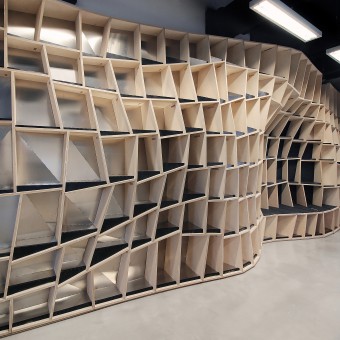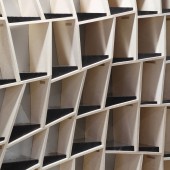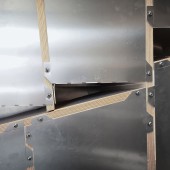Lamellae Multifunctional Shelving by Trevor Ryan Patt |
Home > Winners > #112156 |
 |
|
||||
| DESIGN DETAILS | |||||
| DESIGN NAME: Lamellae PRIMARY FUNCTION: Multifunctional Shelving INSPIRATION: The project was inspired by historical lamella structures that operate through small, discrete elements and a distilled tectonic system. Their geometry, however is limited. I wanted to apply my research into multi-agent systems to resolve the complex spatial interdependencies that such a system would require to adapt to any customized, free-form surfaces. Additionally, using CNC fabrication, seamless joints and continuity between parts could be built into the elements themselves. UNIQUE PROPERTIES / PROJECT DESCRIPTION: Lamellae uses a bespoke multi-agent model to generate a geometrically complex but refined and conceptually precise shelving system that can be endlessly customized to adapt to existing spaces and the display of unique objects. Although it has an almost baroque sculptural presence, awareness of fabrication and assembly constraints coded into the design allow it to be efficiently realized: CNC swarf cutting optimizes fabrication and allows flatpack delivery; aggregation from small, discrete elements enables limitless scaling while dimensions simplifying installation. OPERATION / FLOW / INTERACTION: The shelving unit was designed to display diverse work in fabrication and 3d printing as well as to compile a library of technical research for the entrance lobby of a research centre. This motivated a design with shelves of many different dimensions and the inclusion of a seating alcove within the structure. The generative system behind the piece is much more flexible allowing freestanding spatial forms, even structural vaults. PROJECT DURATION AND LOCATION: This project is located in the foyer of the DManD Research Centre in Singapore. It is the culmination of a research track initiated 2014. Fabrication and installation were completed in October 2019. |
PRODUCTION / REALIZATION TECHNOLOGY: The generative model was custom programmed as a multi-agent model in python. Each lamella unit is represented by an individual software agent that determines its position, adjusts its orientation, checks intersections, and generates the geometry for joining and surfacing. Customization can be controlled by the designer to adjust the pattern, to adapt to the context, and to introduce disruptions to the surface. At any point in the design process, all pieces can be automatically laid out and unrolled for fabrication. In the testing stage, a custom exporter for hotwire cutting was written for machining fullscale mockups directly from the model file. The final project was realized with 5-axis CNC routing using swarf cuts exclusively to minimize machine time and simplify flatpacking for delivery. Each piece is unique and cannot be assembled in the wrong position. The precision allows the wood structure to be assembled entirely by friction fit without fasteners or falsework. The complex geometry and lack of parallel joints is beneficial for structural stability of the assembly. The aluminum inserts are lasercut and hand-folded into place. They are fastened to the back face as a redundant protection against shear forces. Their geometry, especially the location of fastening tabs, is also generated by the multi-agent model. SPECIFICATIONS / TECHNICAL PROPERTIES: Overall dimensions: 7000mm x 3000mm x 900mm Materials: 18mm Baltic Birch Plywood, 1mm Lasercut Aluminum, 7mm Recycled PET Felt Panels TAGS: mulit-agent modelling, generative design, digital fabrication, furniture, installation RESEARCH ABSTRACT: Lamellae develops research on utilizing agent-based modelling in fabrication of highly-refined design work. In this project, each element of the assembly was represented by a unique software object that ensure that piece is within fabrication limits of the CNC machine and the available material dimensions while also generating the complex geometry that gives the project its seamless appearance. This allows unlimited customization of the overall form, unique features like the reading bench here, and adaptation to its surroundings when placed in complex existing conditions. CHALLENGE: This project recognizes the fabrication potentials and efficiency of assembly in the Zollbau lamella structures pioneered in the 1920s. The reciprocal structure of the Zollbau system allowed for large forms to be built out of many, small elements. However, the forms that could be produced were quite limited because any adaptation of the shape had to be propagated through every piece. This research began by using multi-agent modeling to solve the problem of the lamella structure on a free-form shape, utilizing the discrete elements as an expressive element. They suggest a fluid and curvilinear transformation between different display dimensions despite possessing the fabrication efficiency of being milled from flat sheet of plywood. A challenge here was adapting the dynamic multi-agent model to ensure the repeatability and precision required for accurate CNC fabrication and the exact fit of joints. ADDED DATE: 2020-09-30 00:37:39 TEAM MEMBERS (1) : IMAGE CREDITS: Trevor Ryan Patt, 2020. |
||||
| Visit the following page to learn more: https://bit.ly/3uhYagm | |||||
| AWARD DETAILS | |
 |
Lamellae Multifunctional Shelving by Trevor Ryan Patt is Winner in Generative, Algorithmic, Parametric and AI-Assisted Design Category, 2020 - 2021.· Read the interview with designer Trevor Ryan Patt for design Lamellae here.· Press Members: Login or Register to request an exclusive interview with Trevor Ryan Patt. · Click here to register inorder to view the profile and other works by Trevor Ryan Patt. |
| SOCIAL |
| + Add to Likes / Favorites | Send to My Email | Comment | Testimonials | View Press-Release | Press Kit |
Did you like Trevor Ryan Patt's Generative Design?
You will most likely enjoy other award winning generative design as well.
Click here to view more Award Winning Generative Design.








